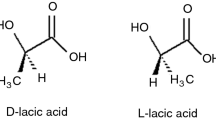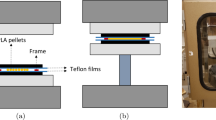Abstract
This research investigated the synthesis of thermoplastic polyurethane (TPU) with a hard segment content (HSC) of 30% weight. The chain extender, the polyols, and the diisocyanate utilized 1,4-butanediol (BDO), and the polycaprolactone diol (PCL-diol) with molecular weights of 2000, 4000, and 10,000 and isophorone diisocyanate (IPDI), respectively. Differential scanning calorimetry (DSC), Fourier-transform infrared spectroscopy (FTIR), hydrogen nuclear magnetic resonance (1H-NMR), and X-ray diffraction (XRD) were used to examine the chemical microstructure and physical properties of PCL diol and thermoplastic polyurethanes (TPUs). The molecular weight of the PCL diol as soft segments affected the crystallinity and glass transition temperature (Tg) of TPUs. An increase in PCL diol molecular weight resulted in a reduction in elongation at failure and an increase in ultimate tensile strength. This study was conducted to investigate the permeability and the permselectivity of CO2 and N2 gases over pressure ranges (3 to 9 atm). It was determined that the gas permeability of each sample increased in response to an increase in the pressure of the supplying gas. An elevation in the molecular weight of PCL-diols in TPU samples resulted in a reduction in selectivity and an increase in CO2 and N2 gas permeability. Although IPDI is a non-aromatic cyclic diisocyanate with a significant impact on thermoplastic polyurethane phase morphology, the goal of this paper is to create a change in the molecular weight of PCL-diol and investigate the effect of molecular weight on the resulting morphology as well.
Graphical Abstract












Similar content being viewed by others
Availability of data and materials
The data created, procured, or used for this research project can be accessed in this manuscript.
References
Das C, Gebru KA (2018) Polymeric membrane synthesis, modification, and applications: electro-spun and phase inverted membranes. Taylor & Francis Group CRC Press, New York, pp 5–11, pp 21–23
Khulbe KC (2021) Nanotechnology in membrane processes. Springer Nature, Switzerland, pp 23–36
Karimi MB, Khanbabaei G, Sadeghi MM (2017) Vegetable oil-based polyurethane membrane for gas separation. J Mem Sci 527:198–206. https://doi.org/10.1016/j.memsci.2016.12.008
Joshi M, Adak B, Butola BS (2018) Polyurethane nanocomposite-based gas barrier films, membranes, and coatings: a review on synthesis, characterization, and potential applications. Prog Mater Sci 97:230–282. https://doi.org/10.1016/j.pmatsci.2018.05.001
Dolmaire N, Méchin F, Espuche É (2006) Water transport in polyurethane/polydimethylsiloxane membranes: influence of the hydrophobic/hydrophilic balance and of the crosslink density. Desalination 199(1–3):118–120. https://doi.org/10.1016/j.desal.2006.03.154
Wypych G (2022) Handbook of polymers. Elsevier, Canada, pp 579–584, pp 665–668
Drobny JG (2014) Handbook of thermoplastic elastomers. Elsevier, New Jersey, pp 9–16, pp 215–221
Mansouri M, Ghadimi A, Gharibi R, Norouzbahari S (2021) Gas permeation properties of highly cross-linked castor oil-based polyurethane membranes synthesized through thiol-yne click polymerization. React Funct Polym 158:104799. https://doi.org/10.1016/j.reactfunctpolym.2020.104799
Maher BM, Rezaali J, Ghaleh H et al (2017) Evaluation of poly (2-hydroxyethyl methacrylate) and poly (methyl methacrylate)-grafted poly (vinylidene fluoride)-poly (dimethyl siloxane) bilayers for gas separation. Colloid Polym Sci 295(9):1595–1607. https://doi.org/10.1007/s00396-017-4124-7
Eusébio TM, Martins AR, Pon G et al (2020) Sorption/diffusion contributions to the gas permeation properties of bi-soft segment polyurethane/polycaprolactone membranes for membrane blood oxygenators. Membranes 10(1):8. https://doi.org/10.3390/membranes10010008
Low SC, Murugaiyan SV (2021) Thermoplastic polymers in membrane separation. https://doi.org/10.1016/B978-0-12-820352-1.00083-3
Melnig V, Apostu MO, Tura V, Ciobanu C (2005) Optimization of polyurethane membranes: morphology and structure studies. J Membr Sci 267(1–2):58–67. https://doi.org/10.1016/j.memsci.2005.04.054
Shahzamani M, Ebrahimi NG, Sadeghi M, Mostafavi F (2016) Relationship between the microstructure and gas transport properties of polyurethane/polycaprolactone blends. IJChE 13(3):78–88
Baker RW (2004) Membrane technology and applications. John Wiley & Sons, California, pp 9–16, pp 215–221
Wolińska-Grabczyk A (2006) Effect of the hard segment domains on the permeation and separation ability of the polyurethane-based membranes in benzene/cyclohexane separation by pervaporation. J Membr Sci 282(1–2):225–236. https://doi.org/10.1016/j.memsci.2006.05.026
Semsarzadeh MA, Sadeghi M, Barikani M (2007) The effect of hard segments on the gas separation properties of polyurethane membranes. Iran Polym J 16(12):819–827
Maghsoud Z, Pakbaz M, Famili MHN, Madaeni SS (2017) New polyvinyl chloride/thermoplastic polyurethane membranes with potential application in nanofiltration. J Membr Sci 541:271–280. https://doi.org/10.1016/j.memsci.2017.07.001
Szycher M (2013) Polyurethanes. Taylor & Francis Group CRC Press, New York, pp 1–6, pp 41–50
Fakhar A, Sadeghi M, Dinari M, Lammertink R (2019) Association of hard segments in gas separation through polyurethane membranes with aromatic bulky chain extenders. J Membr Sci 574:136–146. https://doi.org/10.1016/j.memsci.2018.12.062
Sadeghi M, Talakesh MM, Arabi Shamsabadi A, Soroush M (2018) Novel application of a polyurethane membrane for efficient separation of hydrogen sulfide from binary and ternary gas mixtures. ChemistrySelect 3(11):3302–3308. https://doi.org/10.1002/slct.201703170
Santos GH, Rodrigues MA, Ferraz HC, Moura LC, de Miranda JL (2019) A more sustainable polyurethane membrane for gas separation at room temperature and low pressure. In Materials Science Forum 965:125–132. https://doi.org/10.4028/www.scientific.net/MSF.965.125
Fakhar A, Sadeghi M, Dinari M et al (2020) Elucidating the effect of chain extenders substituted by aliphatic side chains on morphology and gas separation of polyurethanes. Eur Polym J 122:109346. https://doi.org/10.1016/j.eurpolymj.2019.109346
Norouzbahari S, Gharibi R (2020) An investigation on structural and gas transport properties of modified cross-linked PEG-PU membranes for CO2 separation. React Funct Polym 151:104585. https://doi.org/10.1016/j.reactfunctpolym.2020.104585
Turan D, Sängerlaub S, Stramm C, Gunes G (2017) Gas permeabilities of polyurethane films for fresh produce packaging: response of O2 permeability to temperature and relative humidity. Polym Test 59:237–244. https://doi.org/10.1016/j.polymertesting.2017.02.007
Isfahani AP, Sadeghi M, Wakimoto K et al (2017) Enhancement of CO2 capture by polyethylene glycol-based polyurethane membranes. J Membr Sci 542:143–149. https://doi.org/10.1016/j.memsci.2017.08.006
Adam NI, Hanibah H, Subban RHY et al (2020) Palm-based cationic polyurethane membranes for solid polymer electrolytes application: a physico-chemical characteristics studies of chain-extended cationic polyurethane. Ind Crop Prod 155:112757. https://doi.org/10.1016/j.indcrop.2020.112757
Sadeghi M, Semsarzadeh MA, Barikani M, Ghalei B (2011) Study on the morphology and gas permeation property of polyurethane membranes. J Membr Sci 385:76–85. https://doi.org/10.1016/j.memsci.2011.09.024
Liu L, Huang ZM, He CL, Han XJ (2006) Mechanical performance of laminated composites incorporated with nanofibrous membranes. Mater Sci Eng 435:309–317. https://doi.org/10.1016/j.msea.2006.07.064
Eusébio TM, Faria M, Filipe EJ, de Pinho MN (2019) Polyurethane urea membranes for membrane blood oxygenators: synthesis and gas permeation properties. ENBENG 1–4 IEEE
Babaie A, Rezaei M, Sofla RLM (2019) Investigation of the effects of polycaprolactone molecular weight and graphene content on crystallinity, mechanical properties, and shape memory behavior of polyurethane/graphene nanocomposites. J mech behav of biomed 96:53–68. https://doi.org/10.1016/j.jmbbm.2019.04.034
Storey RF, Sherman JW (2002) Kinetics and mechanism of the stannous octoate-catalyzed bulk polymerization of ε-caprolactone. Macromolecules 35(5):1504–1512. https://doi.org/10.1021/ma010986c
Lipik VT, Abadie MJ (2010) Process optimization of poly (ε-caprolactone) synthesis by ring-opening polymerization. Iran Polym J 19(11):885–893
Crescenzi V, Manzini G, Calzolari G, Borri C (1972) Thermodynamics of fusion of poly-β-propiolactone and poly-ϵ-caprolactone. Comparative analysis of the melting of aliphatic polylactone and polyester chains. Eur Polym J 8(3):449–463. https://doi.org/10.1016/0014-3057(72)90109-7
Eyvazzadeh Kalajahi A, Rezaei M, Abbasi F (2016) Preparation, characterization, and thermomechanical properties of poly (ε-caprolactone)-piperazine-based polyurethane-urea shape memory polymers. Mater Sci 51(9):4379–4389. https://doi.org/10.1007/s10853-016-9750-9
Eyvazzadeh Kalajahi A, Rezaei M, Abbasi F, Mir Mohamad Sadeghi G (2017) The effect of chain extender type on the physical, mechanical, and shape memory properties of poly (ε-caprolactone)-based polyurethane-ureas. Polym Plast Tech Eng 56(18):1977–1985. https://doi.org/10.1080/03602559.2017.1298797
Puszka A, Sikora JW, Nurzyńska A (2024) Influence of the type of soft segment on the selected properties of polyurethane materials for biomedical applications. Materials 17(4):840. https://doi.org/10.3390/ma17040840
Funding
The authors declare that no funds, grants, or other support were received during the preparation of this manuscript.
Author information
Authors and Affiliations
Contributions
All authors contributed to the research’s design and implementation, the results analysis, and the manuscript’s writing.
Corresponding author
Ethics declarations
Consent to participate
All authors have participated in the conception, design, analysis, and interpretation of the data, drafting the article, or revising it critically for important intellectual content, and approving the final version.
Consent for publication
All authors confirm that this manuscript has not been published elsewhere and is not under consideration by another journal.
Competing interests
The authors declare no competing interests.
Disclosure
This manuscript has not been submitted to, nor is it under review at, another journal or other publishing venue. The authors have no affiliation with any organization with a direct or indirect financial interest in the subject matter discussed in the manuscript. The authors have no relevant financial or non-financial interests to disclose.
.
Additional information
Publisher's Note
Springer Nature remains neutral with regard to jurisdictional claims in published maps and institutional affiliations.
Rights and permissions
Springer Nature or its licensor (e.g. a society or other partner) holds exclusive rights to this article under a publishing agreement with the author(s) or other rightsholder(s); author self-archiving of the accepted manuscript version of this article is solely governed by the terms of such publishing agreement and applicable law.
About this article
Cite this article
Abedi, R., Maher, B.M., Amirkhani, L. et al. The relationship between chemical microstructure, crystallinity, mechanical properties, and CO2/N2 gases permselectivity of thermoplastic polyurethane membranes. Colloid Polym Sci (2024). https://doi.org/10.1007/s00396-024-05249-8
Received:
Revised:
Accepted:
Published:
DOI: https://doi.org/10.1007/s00396-024-05249-8




